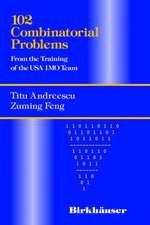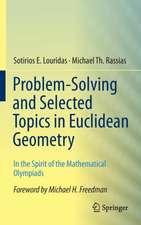Number Theory: Structures, Examples, and Problems
Autor Titu Andreescu, Dorin Andricaen Limba Engleză Hardback – 11 mar 2009
Key features of Number Theory: Structures, Examples, and Problems:
* A rigorous exposition starts with the natural numbers and the basics.
* Important concepts are presented with an example, which may also emphasize an application. The exposition moves systematically and intuitively to uncover deeper properties.
* Topics include divisibility, unique factorization, modular arithmetic and the Chinese Remainder Theorem, Diophantine equations, quadratic residues, binomial coefficients, Fermat and Mersenne primes and other special numbers, and special sequences. Sections on mathematical induction and the pigeonhole principle, as well as a discussion of other number systems are covered.
* Unique exercises reinforce and motivate the reader, with selected solutions to some of the problems.
* Glossary, bibliography, and comprehensive index round out the text.
Written by distinguished research mathematicians and renowned teachers, this text is a clear, accessible introduction to the subject and a source of fascinating problems and puzzles, from advanced high school students to undergraduates, their instructors, and general readers at all levels.
Preț: 538.61 lei
Preț vechi: 633.65 lei
-15% Nou
Puncte Express: 808
Preț estimativ în valută:
103.08€ • 107.22$ • 85.10£
103.08€ • 107.22$ • 85.10£
Carte tipărită la comandă
Livrare economică 12-26 aprilie
Preluare comenzi: 021 569.72.76
Specificații
ISBN-13: 9780817632458
ISBN-10: 081763245X
Pagini: 384
Ilustrații: XVIII, 384 p. 2 illus.
Dimensiuni: 155 x 235 x 30 mm
Greutate: 0.73 kg
Ediția:2009
Editura: Birkhäuser Boston
Colecția Birkhäuser
Locul publicării:Boston, MA, United States
ISBN-10: 081763245X
Pagini: 384
Ilustrații: XVIII, 384 p. 2 illus.
Dimensiuni: 155 x 235 x 30 mm
Greutate: 0.73 kg
Ediția:2009
Editura: Birkhäuser Boston
Colecția Birkhäuser
Locul publicării:Boston, MA, United States
Public țintă
Lower undergraduateCuprins
Fundamentals.- Divisibility.- Powers of Integers.- Floor Function and Fractional Part.- Digits of Numbers.- Basic Principles in Number Theory.- Arithmetic Functions.- More on Divisibility.- Diophantine Equations.- Some Special Problems in Number Theory.- Problems Involving Binomial Coefficients.- Miscellaneous Problems.- Solutions to Additional Problems.- Divisibility.- Powers of Integers.- Floor Function and Fractional Part.- Digits of Numbers.- Basic Principles in Number Theory.- Arithmetic Functions.- More on Divisibility.- Diophantine Equations.- Some Special Problems in Number Theory.- Problems Involving Binomial Coefficients.- Miscellaneous Problems.
Recenzii
From the reviews:
“Number theory is a very important field in mathematics, with many applications in theoretical physics, cryptography and so on. The present book of problems with solutions is a wonderful selection of the basic ideas in this field. … Both authors are outstanding specialists in this field … . This textbook contains eleven chapters with problems and solutions. … This material is very useful for high school students, undergraduate and graduate students, teachers and all lovers of mathematics.” (Carnelia Bejan, IASI Polytechnic Magazine, Vol. 22 (1/4), March-December, 2010)
“This is a collection of elementary number theory problems taken mainly from mathematical olympiads and other contests held in different countries, mainly in recent years. … This makes the book a useful source of material for tests, homeworks, projects, and classroom discussion. … The book is a welcome addition to the library of Problem Books, and will undoubtedly prove valuable to coaches and teams involved in mathematical competitions as well as to university instructors and students.” (Mowaffaq Hajja, Zentralblatt MATH, Vol. 1182, 2010)
"The book is a collection of number theory problems chosen from various national and international Mathematical Olympiads. … Each chapter of this book starts a brief … review of concepts, with various solved examples, mainly selected from Olympiad exams. … The book could be used as a text for undergraduates … . The main audience will consist of Olympiad-level students … . I recommend this friendly volume for students looking for challenging problems in number theory and teachers of number theory for undergraduates … ." (Mehdi Hassani, The Mathematical Association of America, June, 2009)
“Number theory is a very important field in mathematics, with many applications in theoretical physics, cryptography and so on. The present book of problems with solutions is a wonderful selection of the basic ideas in this field. … Both authors are outstanding specialists in this field … . This textbook contains eleven chapters with problems and solutions. … This material is very useful for high school students, undergraduate and graduate students, teachers and all lovers of mathematics.” (Carnelia Bejan, IASI Polytechnic Magazine, Vol. 22 (1/4), March-December, 2010)
“This is a collection of elementary number theory problems taken mainly from mathematical olympiads and other contests held in different countries, mainly in recent years. … This makes the book a useful source of material for tests, homeworks, projects, and classroom discussion. … The book is a welcome addition to the library of Problem Books, and will undoubtedly prove valuable to coaches and teams involved in mathematical competitions as well as to university instructors and students.” (Mowaffaq Hajja, Zentralblatt MATH, Vol. 1182, 2010)
"The book is a collection of number theory problems chosen from various national and international Mathematical Olympiads. … Each chapter of this book starts a brief … review of concepts, with various solved examples, mainly selected from Olympiad exams. … The book could be used as a text for undergraduates … . The main audience will consist of Olympiad-level students … . I recommend this friendly volume for students looking for challenging problems in number theory and teachers of number theory for undergraduates … ." (Mehdi Hassani, The Mathematical Association of America, June, 2009)
Notă biografică
Titu Andreescu received his Ph.D. from the West University of Timisoara, Romania. The topic of his dissertation was "Research on Diophantine Analysis and Applications." Professor Andreescu currently teaches at The University of Texas at Dallas. He is past chairman of the USA Mathematical Olympiad, served as director of the MAA American Mathematics Competitions (1998–2003), coach of the USA International Mathematical Olympiad Team (IMO) for 10 years (1993–2002), director of the Mathematical Olympiad Summer Program (1995–2002), and leader of the USA IMO Team (1995–2002). In 2002 Titu was elected member of the IMO Advisory Board, the governing body of the world’s most prestigious mathematics competition. Titu co-founded in 2006 and continues as director of the AwesomeMath Summer Program (AMSP). He received the Edyth May Sliffe Award for Distinguished High School Mathematics Teaching from the MAA in 1994 and a "Certificate of Appreciation" from the president of the MAA in 1995 for his outstanding service as coach of the Mathematical Olympiad Summer Program in preparing the US team for its perfect performance in Hong Kong at the 1994 IMO. Titu’s contributions to numerous textbooks and problem books are recognized worldwide.
Dorin Andrica received his Ph.D in 1992 from "Babes¸-Bolyai" University in Cluj-Napoca, Romania; his thesis treated critical points and applications to the geometry of differentiable submanifolds. Professor Andrica has been chairman of the Department of Geometry at "Babes¸-Bolyai" since 1995. He has written and contributed to numerous mathematics textbooks, problem books, articles and scientific papers at various levels. He is an invited lecturer at university conferences around the world: Austria, Bulgaria, Czech Republic, Egypt, France, Germany, Greece, Italy, the Netherlands, Portugal, Serbia, Turkey, and the USA. Dorin is a member of the Romanian Committee for the Mathematics Olympiad and is a member onthe editorial boards of several international journals. Also, he is well known for his conjecture about consecutive primes called "Andrica’s Conjecture." He has been a regular faculty member at the Canada–USA Mathcamps between 2001–2005 and at the AwesomeMath Summer Program (AMSP) since 2006.
Dorin Andrica received his Ph.D in 1992 from "Babes¸-Bolyai" University in Cluj-Napoca, Romania; his thesis treated critical points and applications to the geometry of differentiable submanifolds. Professor Andrica has been chairman of the Department of Geometry at "Babes¸-Bolyai" since 1995. He has written and contributed to numerous mathematics textbooks, problem books, articles and scientific papers at various levels. He is an invited lecturer at university conferences around the world: Austria, Bulgaria, Czech Republic, Egypt, France, Germany, Greece, Italy, the Netherlands, Portugal, Serbia, Turkey, and the USA. Dorin is a member of the Romanian Committee for the Mathematics Olympiad and is a member onthe editorial boards of several international journals. Also, he is well known for his conjecture about consecutive primes called "Andrica’s Conjecture." He has been a regular faculty member at the Canada–USA Mathcamps between 2001–2005 and at the AwesomeMath Summer Program (AMSP) since 2006.
Textul de pe ultima copertă
Number theory, an ongoing rich area of mathematical exploration, is noted for its theoretical depth, with connections and applications to other fields from representation theory, to physics, cryptography, and more. While the forefront of number theory is replete with sophisticated and famous open problems, at its foundation are basic, elementary ideas that can stimulate and challenge beginning students. This lively introductory text focuses on a problem-solving approach to the subject.
Key features of Number Theory: Structures, Examples, and Problems:
* A rigorous exposition starts with the natural numbers and the basics.
* Important concepts are presented with an example, which may also emphasize an application. The exposition moves systematically and intuitively to uncover deeper properties.
* Topics include divisibility, unique factorization, modular arithmetic and the Chinese Remainder Theorem, Diophantine equations, quadratic residues, binomial coefficients, Fermat and Mersenne primes and other special numbers, and special sequences. Sections on mathematical induction and the pigeonhole principle, as well as a discussion of other number systems are covered.
* Unique exercises reinforce and motivate the reader, with selected solutions to some of the problems.
* Glossary, bibliography, and comprehensive index round out the text.
Written by distinguished research mathematicians and renowned teachers, this text is a clear, accessible introduction to the subject and a source of fascinating problems and puzzles, from advanced high school students to undergraduates, their instructors, and general readers at all levels.
Key features of Number Theory: Structures, Examples, and Problems:
* A rigorous exposition starts with the natural numbers and the basics.
* Important concepts are presented with an example, which may also emphasize an application. The exposition moves systematically and intuitively to uncover deeper properties.
* Topics include divisibility, unique factorization, modular arithmetic and the Chinese Remainder Theorem, Diophantine equations, quadratic residues, binomial coefficients, Fermat and Mersenne primes and other special numbers, and special sequences. Sections on mathematical induction and the pigeonhole principle, as well as a discussion of other number systems are covered.
* Unique exercises reinforce and motivate the reader, with selected solutions to some of the problems.
* Glossary, bibliography, and comprehensive index round out the text.
Written by distinguished research mathematicians and renowned teachers, this text is a clear, accessible introduction to the subject and a source of fascinating problems and puzzles, from advanced high school students to undergraduates, their instructors, and general readers at all levels.
Caracteristici
Approaches number theory from a problem-solving standpoint, presenting each concept in the framework of an example or problem The text progresses incrementally from simpler to more complex principles Covers modular arithmetic and the Chinese Remainder Theorem, Diophantine equations, binomial coefficients, Fermat and Mersenne primes and other special numbers, special sequences, and problems of density Includes sections on mathematical induction and the pigeonhole principle, and discusses other number systems Unconventional, essay-type, non-routine examples, exercises and problems, presented in an original fasion Includes supplementary material: sn.pub/extras












